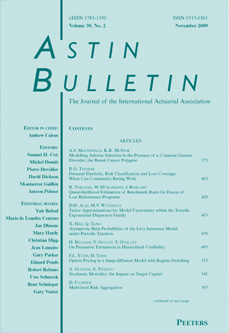 previous article in this issue previous article in this issue | next article in this issue  |

|
Document Details : Title: A Simulation Procedure for Comparing Different Claims Reserving Methods Author(s): PENTIKÄINEN, T. , RANTALA, J. Journal: ASTIN Bulletin Volume: 22 Issue: 2 Date: November 1992 Pages: 191-216 DOI: 10.2143/AST.22.2.2005115 Abstract : The estimation of outstanding claims is one of the important aspects in the management of the insurance business. Various methods have been widely dealt with in the actuarial literature. Exploration of the inaccuracies involved is traditionally based on a post-facto comparison of the estimates against the actual outcomes of the settled claims. However, until recent years it has not been usual to consider the inaccuracies inherent in claims reserving in the context of more comprehensive (risk theoretical) models, the purpose of which is to analyse the insurer as a whole. Important parts of the technique which will be outlined in this paper can be incorporated into over-all risk theory models to introduce the uncertainty involved with technical reserves as one of the components in solvency and other analyses (PENTIKAINEN et al. (1989)). The idea in this paper is to describe a procedure by which one can explore how various reserving methods react to fictitious variations, fluctuations, trends, etc. which might influence the claims process, and, what is most important, how they reflect on the variables indicating the financial position of the insurer. For this purpose, a claims process is first postulated and claims are simulated and ordered to correspond to an actual handling of the observed claims of a fictitious insurer. Next, the simulation program will 'mime' an actuary who is calculating the claims reserve on the basis of these 'observed' claims data. Finally, the simulation is further continued thus generating the settlement of the reserved claims. The difference between reserved amounts and settled amounts gives the reserving (run-off) error in this particular simulated case. By repeating the simulation numerous times (Monte Carlo method) the distribution of the error can be estimated as well as its effect on the total outcome of the insurer. By varying the assumptions which control the claims process the sensitivity of the reserving method visa-à-vis the assumed phenomena can be tested. By applying the procedure to several reserving methods in parallel a conception of their properties can be gained, in particular, how robust they are against various variations and irregularities in the claims process. It is useful to recognize and classify error sources which give rise to the reserving inaccuracies (cf. PENTIKÄINEN et al. (1989) item 2.4b): 1) The model (often simply called reserving rule or formula or method) can be only a more or less idealized description of the real world and of the actual claims settlements; the deviations give rise to what can be termed model errors. 2) The parameters used in calculations are subject to parameter errors owing to the fact that they are to be estimated from various data statistics or found from other more or less uncertain sources. 3) The actual claims and claims settlements are subject to stochastic fluctuations causing deviations from the estimates, stochastic errors, even in those (theoretical) cases where the model and its parameters would be precisely correct. The above procedure enables us to examine the effects of all these three errors, in fact, it is very general, not being restricted to any specific reserving model or assumptions on the claims process. It is intended for studies of the properties of the reserving methods on a general level. However, it is not meant for post-facto analyses, i.e. in the investigation and estimation of the inaccuracies in reserves in particular concrete cases, for those purposes well-known actuarial and statistical approaches are needed. It is still worth noting that the approach can find application to other estimations as well. We have, for instance, also treated premiums in an analogous way, although limited to simple examples in this paper. After having first described our method in general terms a number of numerical examples will be given to illustrate some of its relevant features. They are based on some well-known elementary reserving rules and simple assumptions on the claims process. Also some conclusions on the properties of the reserving rules are derived therefrom. They should be understood merely as examples of the use of our model, not as any real analyses of the reserving methods. Even though our method is aimed at making such conclusions and comparisons between methods, their pertinent performance would require quite extensive studies. Such have been fully beyond the possibilities in this context. |
